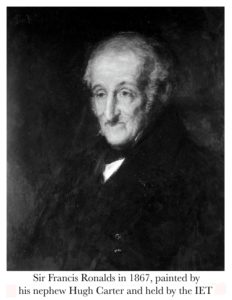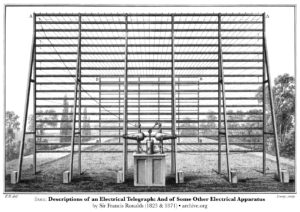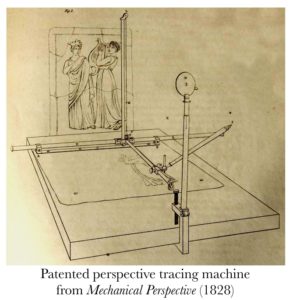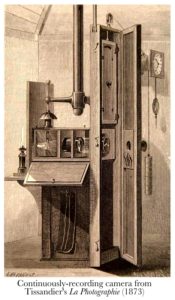
Sir Francis Ronalds (February 21, 1788-August 8, 1873) – inventor, engineer and scientist – is known for building the first working electric telegraph and, while director of the Kew Observatory, the first successful continuously-recording camera. He was also arguably the first electrical engineer.
The second of 12 children and eldest son, Francis was born in the City of London and given his father’s name. He was apprenticed at age 14 and from 18 ran the family’s wholesale cheesemonger business for nearly a decade after his father Francis Sr. died. His mother Jane née Field was a talented woman and, although her youngest child was then just two, with Francis’ assistance she brought up her large family most capably in her husband’s absence.
Jane encouraged and assisted her children to follow their dreams. Home-life was stimulating, with a shared love of learning that embraced politics, literature and the arts as well as science. Enhancing society through personal betterment was a key theme, and the family had active involvement in antislavery and the co-operative movement. The means by which Francis strove to make a difference was technology and he wrote at the end of his life: “I only cherish a hope that… I may have contributed in some degree to the sum of human knowledge and happiness”.
He grew up regarding women as equals and with respect for different cultures and peoples. As he observed on the Nile in 1820 of a group of Egyptian farmers under the control of Turkish soldiers: “If we will treat them as savages we must expect that they will be rather savage towards us I think. I can clearly discover great affection and hospitality towards each other and is not this the proper test of character?”
Ronalds described himself as “a Unitarian born, bred and educated”. So too were his close-knit extended family and many of his circle – solicitor Samuel Carter was his brother-in-law and Thomas Field Gibson, a silk manufacturer, was his first cousin. He illustrated his religion in his characteristically unpretentious style when he described Jacopo Bassano’s art as being “Unitarian”: “He makes Mary a good wholesome Dame, Joseph a country lad[?], & Jesus a chubby little fellow always ready for the bottle & the society of this holy family generally consists in a conclave of Cows & Pigs… he did not care to leave natural for supernatural objects. Truth for Mystery.” He also freely questioned his faith as he did scientific hypotheses, writing in Constantinople: “I fell into some comparison between Unitarianism & mohammedism & I was not surprised to find that we agreed on a great many points”. He supported various Unitarian causes, including being a lifetime subscriber to the Unitarian Fund, and kept the notes he made on the doctrine of necessity based on Thomas Belsham’s writings; Francis Sr. had told Belsham that “I believe no minister was ever more highly esteemed by his congregation”.
In the nature of his religion, Ronalds was a modest man and consistently understated his achievements, but this gave the opportunity for others to take credit due to him. Such scientists included the director of the Royal Observatory at Greenwich, who regarded the Kew Observatory as a competitor; Ronalds’ initial overseer at Kew, whose part in commercialising the telegraph generated his fortune; and Ronalds’ early collaborator in electrical science. It took decades for him to come to terms with such behaviour but he was aided by the knowledge that he himself had always acted with integrity.
He attended two schools, run by the essentially Unitarian ministers Nathaniel Philipps and Eliezer Cogan. Worshiping at the Gravel Pit Chapel in Hackney where Francis Sr. was treasurer, the family interacted with Joseph Priestley. Ronalds tried off and on through his life to complete an update of Priestley’s text The History and Present State of Electricity but did not succeed.
Beginning his own experiments in electricity at a young age, Ronalds’ work was quickly distinguished by its emphasis on the possibilities for practical use of the not-yet understood power source for the benefit of humankind. His first important invention, a form of electric insulation, received public notice in early 1811, although his colleague did not share the credit with him. He published the first battery-operated clock in 1815 as his third paper in the Philosophical Magazine, which this same colleague condemned in the journal as being “an electrical toy”.

The next year, he built two electric telegraphs in his mother’s garden – a 13 km (8 mile) long overhead system and a subterranean one. They were powered by a semi-automated electric generator of his invention that provided a constant supply of charge with minimal manual effort. He also foresaw and explained the risk of signal retardation in insulated cables due to induction, which was to prove problematic decades later in the telegraph network. Finally, he wrote prophetically in his book
Descriptions of an Electrical Telegraph and of some other Electrical Apparatus (1823): “Let us have electrical conversazione offices, communicating with each other all over the kingdom”. The Government disagreed, telling him in 1816 that the telegraph was “wholly unnecessary”. They were happy with semaphore.
Ronalds being very diffident, and the world not yet ripe for the electrical age, he “bid a cordial adieu” to electrical invention at this time. His work slowly became recognised, however, with the 1842 and 1855 editions of the Encyclopædia Britannica covering many of his early electrical science and engineering activities.
He embarked on one of several long overseas sojourns in 1818, conducting electrical experiments on the erupting Mt Vesuvius and acquiring books on electricity towards what would become the “Ronalds Library”. He documented his growing collection with the first practical card catalogue.
After his return to England, he took a new direction and did not publish again in the Philosophical Magazine for over 30 years. His focus was now on mechanical design and engineering and he created a wide variety of devices for himself and colleagues.

In 1825 he patented two drawing machines. One was an aid to engineering and architectural communication and made a perspective view of an object directly from drawings of its plan and elevations. The other enabled a scene to be traced from life quickly and easily and proved popular for portraiture in the pre-photography era. He had taken care to avoid the problem with many earlier drawing instruments “which have been invented by unartist-like mechanics, and rejected by unmechanical artists”. To support his drawing machine, he also invented what soon became – and remains – the classic portable tripod stand with three legs hinged to a triangular metal head. He built a semi-automated production facility and printed a description of the devices and their use called Mechanical Perspective (1828) to assist his customers; several hundreds of the machines were sold.
He utilised the second drawing instrument, along with several surveying tools he invented, in making a detailed survey of the Neolithic standing stones near Carnac, Brittany, in 1834 with family friend Alexander Blair. Their preliminary results were printed in book form as Sketches at Carnac (1836); Unitarian friends James Yates and Samuel Sharpe, who both had antiquarian interests, encouraged its dissemination despite the authors’ own reticence. In the twenty-first century, Ronalds’ lithographs continue to be valued by the archaeological community as having “quasi la precision d’un cliché photographique”.
Ronalds also enjoyed turning. One of various attachments he developed for his lathe automated the creation of any desired shape along the length of the spinning work piece. Over 50 years later, the renowned London toolmakers Holtzapffel – who still manufactured and sold the device – described it as containing “the germ of all the turning and carving machinery since so extensively employed for the mercantile production of numerous fac-similes” in the new era of mass production.
As a further example from this period of his life, Ronalds helped research and write his brother Alfred’s book The Fly-fisher’s Entomology (1836). One of his contributions was to delineate the window of vision through which a fish sees its potential captor, using his understanding of optics.
Serving as the inaugural honorary director of the Kew Observatory was the climax of Ronalds’ career. He was enticed out of his nearly anonymous mechanical world in 1842 and over the next decade created many meteorological instruments for the new observatory. These included equipment to observe atmospheric electricity and to register physical parameters automatically, in both of which he had first achieved success 30 years earlier. The quality of his new generation of instruments and observations brought Ronalds to the centre of British science at the same moment that the electric telegraph was finally becoming a reality. He was elected a Fellow of the Royal Society in 1844. Two booklets describing his inventions at Kew were printed – Epitome of the Electro-Meteorological and Magnetic Observations, Experiments, &c. made at the Kew Observatory (1848) and Descriptions de quelques Instruments Météorologiques et Magnétiques (1855). Many of the instruments were displayed at the 1855 Exposition Universelle in Paris, organised by his Kew colleagues after his departure.
 In the most noteworthy of these inventions, he utilised the new invention of photography in creating cameras to record the indications of a scientific instrument minute-by-minute through the day and night. His achievement was awarded a prize of £250 by the British Prime Minister in 1849 because of its importance for observational science. His photo-magnetographs were used in international studies to help understand the continual perturbations of the earth’s magnetic field. Other cameras recording barometric pressure, temperature and humidity were employed by the new UK Meteorological Office from the early 1860s to develop the science of weather forecasting and also in observatories around the British Empire into the 20th century. Kew had become probably the leading meteorological and geomagnetic observatory in the world.
In the most noteworthy of these inventions, he utilised the new invention of photography in creating cameras to record the indications of a scientific instrument minute-by-minute through the day and night. His achievement was awarded a prize of £250 by the British Prime Minister in 1849 because of its importance for observational science. His photo-magnetographs were used in international studies to help understand the continual perturbations of the earth’s magnetic field. Other cameras recording barometric pressure, temperature and humidity were employed by the new UK Meteorological Office from the early 1860s to develop the science of weather forecasting and also in observatories around the British Empire into the 20th century. Kew had become probably the leading meteorological and geomagnetic observatory in the world.
On his retirement from Kew at age 65, Ronalds returned to the European Continent for nearly a decade where he continued to advise and assist observatories regarding his meteorological apparatus and collected further books for his library. He then settled at Battle, in East Sussex, for the last decade of his life.
Installation of the transatlantic telegraph in 1866 triggered public calls for the original inventors to be honoured and Ronalds was knighted in 1870. Demand for his book required Descriptions of an Electrical Telegraph to be republished the next year. At the same time, the Society of Telegraph Engineers (STE) was founded to support the new profession of electrical engineering that the telegraph had spawned. Ronalds was invited to join the Society – which was soon renamed the Institution of Electrical Engineers – and comments made by fellow members before and after his death show that he was regarded as the first of their discipline. His now large library was bequeathed to the STE and provided a scholarly base for the new profession. His Catalogue of Books and Papers Relating to Electricity, Magnetism, the Electric Telegraph, &c. including The Ronalds Library was published in 1880 and has recently been reprinted by Cambridge University Press.
Sources
His personal papers and much of his surviving correspondence, along with the Ronalds Library, are held in the Ronalds Archive at the Institution of Engineering and Technology (IET) in London, England. Other important primary sources are the Ronalds Papers at the University College London (UCL) Library; the Library and collections at the Royal Society; Cambridge University Library in Cambridge, England; and the UK National Meteorological Archive in Exeter, England. The Ronalds Family Papers in the Harris Family Fonds at Western University in Ontario Canada are the principal depository for the extended family. A memoir based on Ronalds’ papers and with family input was published by the Society of Telegraph Engineers (STE) in 1880 and a retrospective view by another member of the institution in Pioneers of Electrical Communication (1930). For a comprehensive biography see Beverley F. Ronalds Sir Francis Ronalds: Father of the Electric Telegraph (2016). There is an entry in the Oxford Dictionary of National Biography (DNB). In addition to the books mentioned above, Ronalds published six papers in the Philosophical Magazine, two in the Quarterly Journal of Science and the Arts, and one in the Philosophical Transactions of the Royal Society, as well as detailed annual reports for the Kew Observatory in the British Association for the Advancement of Science meeting papers. Obituaries can be found in the London Times (August 12, 1873), the New York Times (August 25, 1873), and other newspapers and journals.
Article by Beverley F. Ronalds
Posted January 14, 2017